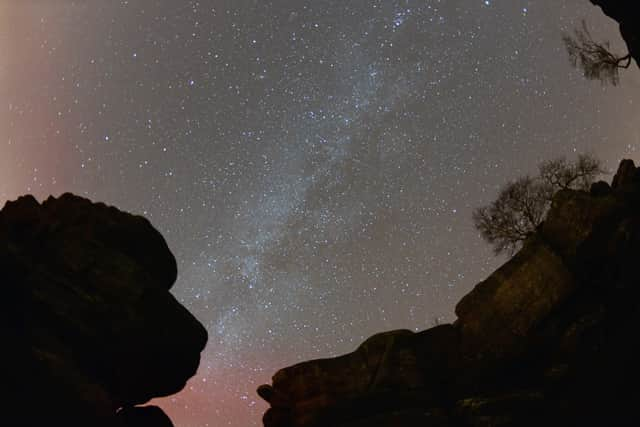Harrogate named as fifth best place for back-garden stargazing


Many people will be wanting to take advantage of the warmer nights by spending the evening gazing at the stars, but some locations have a better chance of viewing the night sky than others.
Harrogate has been listed in the top 20 by The Paint Shed, which analysed 182 locations using several data points such as the access to private gardens, air pollution, light pollution and precipitation to discover which UK locations were the best for garden stargazing.
Advertisement
Hide AdAdvertisement
Hide AdHarrogate came in fifth, with a total score of 209. Although the district did not come in top for any individual factors, its air pollution rank was one of the lowest as well as scoring fairly well for artificial brightness. The days of rainfall let Harrogate down with 85 days, which was among the highest.
Lincoln scored best overall, making it the top location in the UK for astronomy enthusiasts to live. Leeds was revealed to have the worst gardens to stargaze from, scoring especially high for factors such as annual rainfall, days of rainfall and artificial brightness.
Such is the pull of Harrogate skies that Rudding Park Spa in Harrogate has embraced the stars and their natural beauty. While the venue may not be located in an official dark sky area, it is however out of town and on the edge of a dark sky park.
Guests with access to the Roof Top Spa and Garden can relax under the night sky and experience rooftop starbathing, where, on a clear night from September to March, the Roof Top Spa telescope provides wonderful wide-field views of comets, star fields, star clusters, nebulae, bright galaxies, planets and the Moon.
Advertisement
Hide AdAdvertisement
Hide AdRudding Park often collaborates with North Yorkshire astronomer Richard Darn, who helped establish Europe’s largest Dark Sky Park. Together, they often organise an extremely popular overnight Stargazing Experience, which includes an insight from Richard on how people can guide their way around some of the more easily recognisable features of the night sky; before venturing outside to observe it for themselves.
A spokesman said: “Reconnecting with nature has never been more popular. Gazing at the stars can have a positive impact on mental health, from calming the mind and boosting feelings of closeness with nature to fostering kindness. According to a study in the Journal of Personality and Social Psychology, feeling a sense of awe from stargazing diminishes the emphasis on the individual self and can promote altruistic behaviour.
“The stars have fascinated people for thousands of years and knowing just a little bit about them only adds to the sense of wonder.”
The Harrogate borough is also home to four official dark sky discovery sites in Nidderdale Area of Outstanding Natural Beauty and these are great places to start your stargazing adventure.
Advertisement
Hide AdAdvertisement
Hide AdThese locations are officially recognised as excellent places to stargaze and are open to the public, have car parking and are accessible for people of all abilities. The four sites are: Toft Gate Lime Kiln; Scar House Reservoir; Fewston Reservoir; and Thruscross Reservoir.
Look out for the Milky Way directly overhead during autumn and early winter evenings and you will see a shimmering river of light streaming through the constellations of Cassiopeia and Cygnus. The darker your skies the more prominent it is to the naked eye. The soft glow is actually caused by the light of millions of dim stars (visible in binoculars) and it is one of the spiral arms of our own galaxy, a vast system of stars held together by gravity.
You could also see: the Northern Lights (aurora borealis), a naturally occurring phenomenon that gives a stunning light display in the sky; Meteors - it’s a good time of year right now to see the Perseid Metor shower, which occurs each year between July 17 and August 24, peaking around August 9-13; the Moon - the skies are at their darkest at the time of the New Moon – two weeks after a Full Moon; and the International Space Station, which orbits the earth every 90 minutes and will often pass you overhead throughout the year. It can be seen with the naked eye and looks like a high and fast moving aeroplane.
Anyone who is interested in finding out more about the skies and stargazing could pop along to the next meeting of the Harrogate Astronomical Society - a warm and friendly group which is open to anyone with an interest in astronomy.
Advertisement
Hide AdAdvertisement
Hide AdThe group’s monthly meetings are held on the last Thursday of the month at 7.30pm at Harlow Hill Community Centre (The Green Hut), Harlow Avenue, Harrogate.
For more information, or to join the society, email [email protected], or follow the group on Facebook at: www.facebook.com/HarrogateAstronomicalSociety or Twitter @HarrogateAstro.
To book a spa experience online at Rudding Park’s website, go to: https://www.ruddingpark.co.uk.